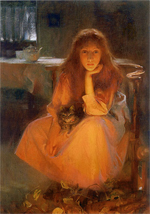
The Contours of Realism
"But she loves the scene the better for its sadness:
there is some pity in it" (113).
Points
for Reflection
G. Eliot's "Silly Novels by Lady Novelists" (1856; 1856)
- does “Mr. Gilfil’s Love Story” thus far avoid the criteria Eliot uses to malign the mind-and-millinery species of lady’s fiction? What of the oracular species, and that of the white-kneckcloth school?
G. Eliot's "Mr. Gilfil's Love Story" (1857, 1858), chps. 1-8, Scenes of Clerical Life
- Eliot’s narrator observes early on that Mr. Gilfil, the recently deceased Vicar of Shepperton, “did not shine in the more spiritual functions of his office,” that he completed these “with undeviating attention to brevity and dispatch” (73-74). Is Eliot’s portraiture of the Vicar, Mr. Gilfil, that of a failed parson?
- do the Gothic architectural features of the redesigned Cheverel Manor somehow reflect the character traits of its owner, Sir Christopher, or does the baronet appear to be a fish out of water in his own estate?
- is Sir Christopher Cheverel readily categorizable as either a hard and insensitive, or a kind, landlord?
- note the various descriptions of art at Cheverel manor (90, 92, 102). Are there any characters in this tale that function more as pieces of art themselves than as fully realized human beings?
- the narrator goes out of his way to explain his dedication to verisimilitude—to describing characters and situations as they, respectively, really behaved and occurred (79-80). Is this tale thus far “realistic”?
- which of these characters is the most emotionally mature? Which knows his/her feelings best, and allows emotion to mix with thought in shaping personal behavior?
- is Lady Cheverel an independent, self-confident agent in the story of her own life, or is she a deferential, secondary character in the life of her husband?
- is Caterina more a symbol or type than she is a three-dimensional character, or does George Eliot endow her with significant depth?

Fire Fancies (1895)
Arthur Hacker
Dr. Paul Marchbanks
pmarchba@calpoly.edu
![]()
